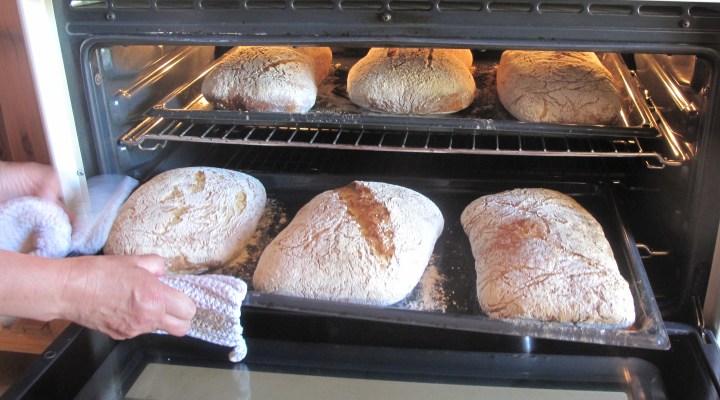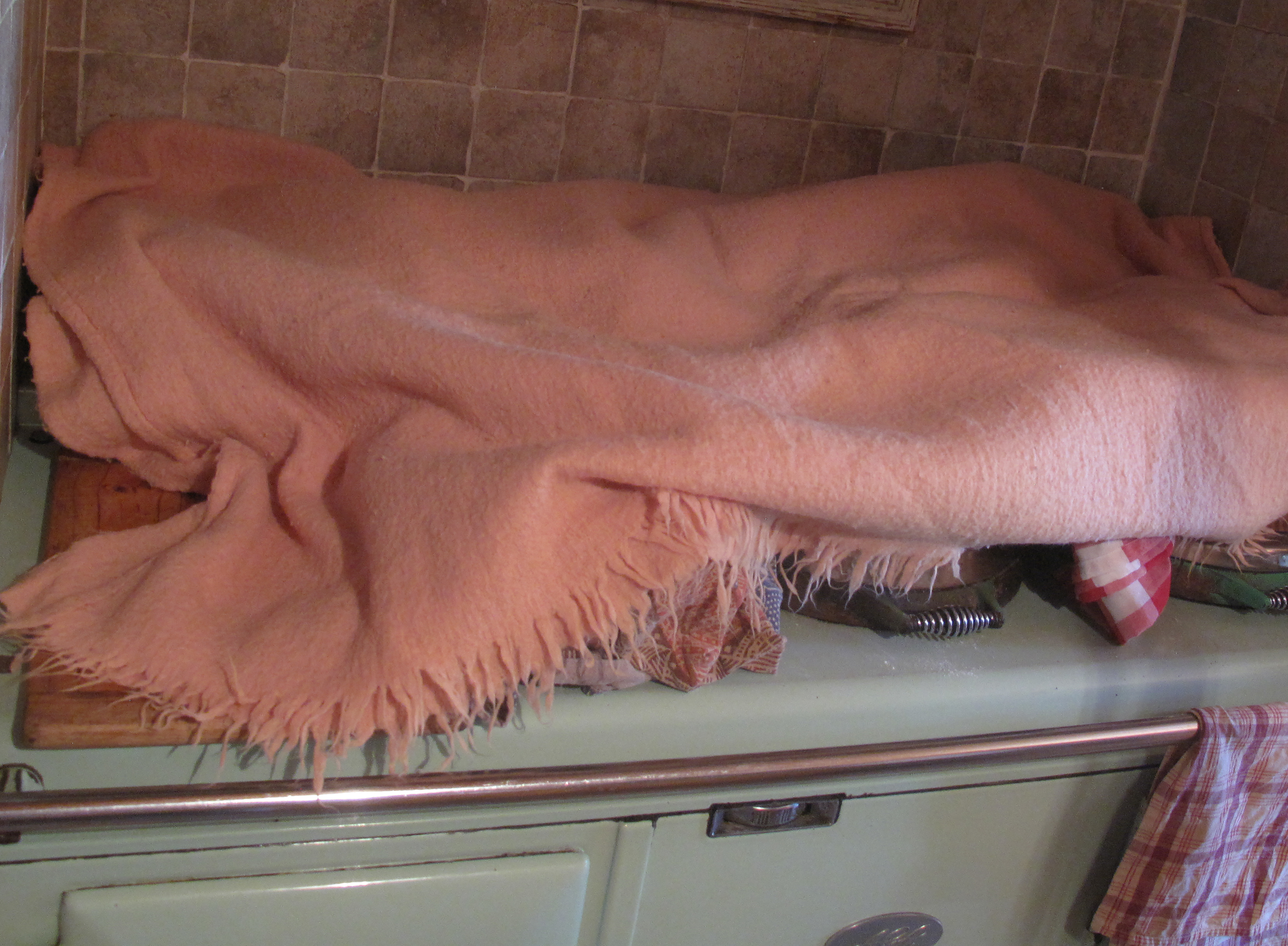GASTROTURF
Knead2Know: An abundance from Farm to Table

A farmhouse kitchen, wooden cupboards, ancient green Aga stove, even enamel Aga cooking pots. A cooking class – you’re to learn how to make ciabatta from scratch, how to make your own ricotta, and to churn your own butter. Best of all, acquaintances are about to become friends. It’s just like Bill Withers’ perfectly lovely day.
When we first arrived in Cradock in late 2014, bruised but not defeated after having left mainstream newspapers thanks to the machinations of one Iqbal Survé, we found ourselves running a little bistro and tea room. On our first day of business, a stranger arrived at the front door with a vase containing a magnificent array of flowers. It was her welcome to the town and her hope that everything would go very well for us.
She was Lani Lombard, who had (still has) a restaurant and shop in the town. A couple of years later, Lani and her daughter, Louzel, pitched up on the TV cooking competition show, My Kitchen Rules, and very nearly won. We supported them from our living room couch with gusto, yelling at the screen like Blue Bulls supporters in a sports bar. (We stopped short of yelling “Vat hom, Lani!”)

Lani Lombard and Louzel Lombard Steyn in front of the Aga on Waterval farm, in the Midlands Karoo. Photo: Tony Jackman
In the meantime, the little bistro had kept us going for some months, but then Daily Maverick came into our lives, so we happily fell back into full-time journalism. But the food thing has remained in our lives through the four-plus years of living in the Midlands Karoo, from visits to the dining room of the Victoria Manor Hotel to having brunch at True Living (Lani’s place), eating at The Shed or Vino’s and, once a year, being a modest part of the annual Karoo Food Festival, in which the Lombard women always play a part as well. (This year’s festival is from 26 to 28 April, in Cradock. We will be hosting a Karoo Dinner on the evening of Saturday 27 April in our home, and no prizes for guessing that this will involve lots of Karoo lamb. The dinner is organised by Hello Cradock and full details of the entire festival can be found here. Note the Lombards’ workshops too.)
Slowly, you get to know the greater environs of the small town you’ve moved to, one friend pointing out that we shouldn’t think of Cradock as only the town, as the massive farming community on all sides was a part of it.
This is sheep country, for both meat and wool (cattle too, and the odd confused goat), and it’s also pecan country, so the dessert on our menu is going to be a traditional brandy tart but made with Cradock pecans. With luck and a bit of practice we hope also to have home made butter on the table, which brings us back to Lani and Louzel Lombard.
The other day we got a WhatsApp from Louzel, inviting us to a cooking workshop on their farm. “Breaking Bread with Lani & Louzel” would celebrate the process of cooking from “Farm to Table – an immersive foodie experience in the heart of the Midlands Karoo”.
Louzel, who is a journalist in her real life (more about that later), described the event: “You’ll be involved in hands-on workshops and demos on the baking of artisanal breads and the various ways in which it can be prepared. There will be a minimum of three hands-on workshops, demos and classes including, but not limited to, bread making, butter making, cheese making, and the making of jam and/ or chutney.”
I was thrilled to be invited to the bread-making part of this. But I jumped up and down with excitement when I realised that we’d be doing the whole lot that day. A perfectly lovely day lay ahead:
Picture the kitchen in which you’re doing this: the prototype of what you’d imagine a farmhouse kitchen to be. Each of the seven of us had a proper old-fashioned beige baking bowl to work in. The flour was stoneground. The bread proved on the warmth of an Aga stove. The vegetables for the lunch were picked in the farm garden. The game sausages were home made. The dog’s name was Cowboy. And you even got a goodie bag of farm-grown thyme and basil, garlic, chillis, peppers and spring onions, a square of muslin cloth, a little jar of the apricot jam you helped make (I gave it the odd stir), and the loaf of ciabatta you’ve just made yourself.

Everyone got to use a lovely old beige baking bowl.
The journey there… there’s another story. A sturdy vehicle is recommended for the juddery gravel road. Eventually you’re up against a mountain and looking up you see a narrow road snaking all the way to the top. Once on top, stop and look back at the view behind you. Sensational doesn’t come close. There’s still a way to go, and once through the farm gate, slow down to a crawl and mind the bumps and stones. But, even in my tiny Toyota Aygo, we got there.
An aproned Lani and Louzel step onto their wide stoep, and in we go. There’s welcome coffee, then we’re into the kitchen and shown our stations, where we each have a beige baking bowl, 500g/ml of warm water, 500g/ml of Eureka brand stoneground white bread flour (already measured) and eight grams of real yeast (wet, not dried/powdered). It looks like a little grey lump of clay. Fresh wet yeast, it turns out, can be bought at the deli counters of our local supermarkets. I had not known that. Next day I went to buy some myself.
Lani tells us that we’re making the quick-style ciabatta, the one with smaller holes; the formal recipe would have required starting the night before by making a starter dough called a poolish. In our goody bags, which we’re to get later, there’s a typed-out list of the recipes and, thoughtfully, it includes how to make the poolish the night before should we want to: Mix 1g yeast (you’ll need a set of those tiny measuring spoons) into 500g water, and mix into 500g sifted white bread flour. Cover and leave for eight hours.
But we start, in the morning, with this: add 20g salt to a little of the water and stir with your fingers until dissolved. Mix 14g yeast into a separate small bowl of a little water until dissolved. Make a well in the flour and pour in the salt water, then the yeast water, and start working the flour in with your hands. (Or, as the recipe says, “fold until elastic, do not overmix”.)
Cover and place on your Aga (or the best facsimile you have) to prove for 45 minutes while you go to the big farmstead lounge for a breakfast of fresh fruit, muffins, and more coffee.

Our Ciabatta dough proving on the Aga stove top.
When 45 minutes have gone by we’re back in the kitchen to retrieve our now warm bowls from the Aga, where we find that Lani has placed a big fluffy beige blanket over them all. It matches the old baking bowls. There’s love in this kitchen, and in these loaves.
We scrape our dough on to our floured surfaces and start to fold. Down towards us, up away from us, left to right, and right to left, then again, but not too many times: the trick, Lani explains, is to learn to “feel” when the dough is starting to resist you. That’s when to stop – and to my amazement, I quickly do feel it, and I stop, shape the loaf as instructed, and we cover them again and back to the Aga they go, for another 45 minutes “or until they double in size”.
It’s Louzel’s turn now – she’s showing us how to make ricotta, butter, and apricot and ginger jam. Louzel pours 4 cups fresh full fat farm milk and a quarter teaspoon salt into a pot. (Don’t use pasteurised, she says, it won’t curdle.) The milk is scalded until steam starts rising from the surface (not boiled) and she grates nutmeg on top and gently stirs in 3 Tbs lemon juice. The milk starts to separate into curds and whey, just like Little Miss Muffet said. The curds are carefully skimmed off with a slotted spoon and put into the muslin over a bowl, to strain the whey a-whey, as I said to Lani, who had the grace to chuckle. Louzel says it should be left for at least two hours and then flavoured with a little olive oil and salt and herbs of your choice.

Louzel’s Ricotta, straining.
I’ve been watching Louzel at work, and how confident she is, and how deeply she knows her food and ingredients, and it becomes perfectly clear: she has to write for us. And she will be, and is delivering her first food story next week.
Next: home made farm butter. For this you need 500ml heavy cream which has been refrigerated overnight so that it’s very thick. And salt. They used a vintage Kenwood electric mixer, first churning using the whisk fitting, in spurts rather than continuously it. You’re looking for it to separate and form butter curds, and in a bowl you use your hands to squeeze out as much moisture as you can. Repeat until a solid, soft butter starts to form, then transfer it to a wooden board and salt it generously. We used a wooden butter pat to bash the life out of it. Then Louzel got all creative, taking clumps of the freshly made butter and seasoning each differently. Herbs went into some, chilli into another, another was peppery, another garlicky. They were all to come out for lunch along with the sausages, the venison carpaccio, the bread, the abundance of everything.

Butter after its second churn, the butter curds having separated from the buttermilk.
All the while, we’d taken turns stirring the apricot and ginger jam. By the end, it was burbling creamily, so much so that I thought they’d actually put cream in it. It was left to cool. We still have some in the fridge.
Now it was time to collect our bowls again from the Aga and scrape them back onto our floured surfaces, then fold again and then stop, shape, and place them side to side on towels with a fold of towel between each, to stop them spreading.
Then, onto a sprayed oven pan and into a 220C oven into which you’ve also placed a pan at the bottom with a little water in it, to create a steam which will stop the crust from becoming too hard – 30 minutes later (up to 40) and out it comes. Just like in the picture:

That’s my loaf, right there. Sounds hollow when tapped.
While the kitchen’s being cleaned and lunch served, Lani takes us on a tour of her herb and vegetable garden. Asparagus, broccoli, cabbages, chillies, capsicums, butternuts, courgettes, cauliflower, carrots, and much more besides, all interspersed with every flower you’ve ever seen. Including every flower in that arrangement she’d picked for us, in that very garden, four years earlier to take as a welcome gift for the new people with the tea room in town. How wonderful is that.
This is my thank you. DM
To enquire about Lani and Louzel’s farm workshops, contact Louzel Lombard Steyn on 082 442 3543 or email [email protected].
Tony Jackman’s book, foodSTUFF (Human & Rousseau), a cookbook-cum-memoir with essays about life, food, living, family and even grieving and illustrated by 60 recipes, was nominated for the Gourmand World Cookbook Awards (2018) in the category for best food writing. Book enquiries: [email protected]





 Become an Insider
Become an Insider